
Contents
3. Method of performing the vrat
4. What is the significance of worshipping Shakti during nine days of Navratra ?
5. What Name should we chant during Navaratra ?
6. Curb malpractices during Navratri and preserve the sanctity of the festival
1. History of Navratra
A) This vrat was advocated by Sage Narad to ShriRam, so that He could kill Ravan. After completion of this vrat, ShriRam attacked Lanka and finally killed Ravan.
B) The Goddess fought with the demon Mahishasur for nine days from Pratipada to Navami and finally killed him on the Navami night. Since then, She came to be known as Mahishasurmardini, the annihilator of Mahishasur.
2. Importance
A) Whenever the tamasik, demoniacal and cruel people become powerful and start troubling the sattvik, righteous humans, the Goddess incarnates to reinstate Righteousness. This is the vrat of this Deity.
B) During Navaratra, the Goddess Principle is a thousand times more active than usual.
3. Method of performing the vrat
In several families, this vrat is undertaken as a family tradition. This vrat begins on Ashwin Shukla Pratipada.
O Mother ! You are the personification of all that is auspicious, You are the benevolent form of Deity Shiva, You bestow Shakti (Divine Energy) and help people abide by Dharma, beget wealth, fulfill desires and Moksha; You are worthy of being surrendered to. Three eyes adorn You. O Narayani Devi, I pay obeisance to You !
A) In a sanctified place in the house, a vedi (sacrificial fireplace) is constructed and the Goddess with eight arms seated on a lion and the Navarna yantra are installed. Beside the yantra, a pot (also known as ‘ghat’) is installed and puja of both the pot and the Goddess is performed.
B) In the festival of Navratra, as per the tradition, rituals of ghatasthapana and mala-bandhan should be performed. A square base with height equal to that of two fingers should be prepared with sand brought from a farm and (five or) seven food grains should be mixed in it. These seven food grains are barley, wheat, sesame seeds, lentils, grams, rale and save (foodgrains found specially in Maharashtra).
C) In the pot of sand or copper, substances such as water, gandh, flowers, durva, akshata, betel nut, five specific leaves, five gems or coins should be put.
D) If one does not know the Vedic mantras for installation of the seven food grains and the kalash (signifying Varun, the Deity of rain), then mantras from the Purans should be recited. If one does not know even these, then one should say ‘I offer’ ‘समर्पयामि (the name of the substance offered)’ and chant God’s Name. A garland of flowers should be tied in such a way that it reaches inside the pot.
E) A kumarika (virgin) is worshipped daily for nine consecutive days and is offered meals. A married woman signifies manifest energy while a kumarika represents unmanifest energy. Since some amount of manifest energy is utilised in a married woman, the total energy in a kumarika is more than that in a married woman.
F) ‘The festival of Navratra is celebrated according to one’s financial capacity and ability, with various programmes including akhand deep-prajvalan (continuous burning of a lamp), Chandipath (recitation of verses of the Goddess), Lalita-puja (ritualistic worship of Lalita) and Saraswati-puja (ritualistic worship of Saraswati), fasts, keeping awake as a ritual etc.
G) Even if a devotee is fasting, naivedya should be offered to the Goddess as usual.
H) During this period, as part of good conduct one should not shave, should observe strict celibacy, should not sleep on a bed or mattress, should not cross the border of the village and should not wear footwear.
I) Attributing significance to the number of the day in the Navratra, some observe it even on the last day; although according to the scriptures it should be concluded on that day. On that day, after the prasad in the form of food is served to people, if time permits then all the Deities should be removed, abhishek performed and shodashopchar-puja performed. If there is no time, then the abhishek and puja of all Deities should be done on the following day.
J) During the immersion of the idol of the Goddess, the germinated seeds are offered to Her. Women carry those small plants for immersion, as the Goddess ‘Shakambhari’, on their heads.
K) When installing and concluding the Navratra, it is necessary to sanctify the Deities. As usual lemon, bhasma etc. are substances used in the abhishek. One should not use rangoli or powder used to clean vessels for the abhishek.’
L) Finally the installed ghat and the Goddess should be immersed in flowing water.
M) In any religious ritual like Navratra, when a lamp is lit continuously as a part of puja, if it blows out because of the wind or due to lack of oil or carbon formation etc. those causes should be corrected and the lamp should be lit again. As penance, the Name of the presiding Deity should be chanted one hundred and eight or a thousand times.
N) Pray to the Goddess thus – “O Goddess, we have become powerless, attached to Maya (The great illusion) by pleasure and sensual enjoyments. O Mother, be the source of our strength. With Your strength we will be able to destroy evildoers.”
O) Blowing into the pots: On the day of Ashtami, women worship Goddess Mahalakshmi and blow into the pots.
P) Regional variations: In Gujarat to symbolise the matrushakti during Navratra, a deep-garbh (lit lamp placed in an earthen pot with many openings) is worshipped. The word garbha-garbho-garbo or garba deleting the word deep became prevalent because of the ‘deep-garbh’ worshipped during the nine days, to represent female reproductivity.
4. What is the significance of
worshipping Shakti during nine days of Navratra ?
The word asur is derived from ‘असुषुरमन्तेइतिअसुर:|’, meaning ‘the one who remains engrossed only in enjoying life and in the indulgence of pleasure of the objects is an asur (demon)’. Such a Mahishasur is present in each human heart. And he has taken control over internal Divine qualities of the human being. It is necessary to perform puja of Shakti to become free from the trap of Mahishasur, by realising the illusory form of this Mahishasur. Therefore, Shakti should be worshipped in the nine days of Navratra. This victory is celebrated on the day of Dashami and is called Dussehra.
5. What Name should we chant during Navaratra ?
In Navaratri, according to one school of thought, tama-predominant Shri Mahakali devi is worshipped on the first 3 days to reduce Tama component in ourselves. The next 3 days, worship the Raja-predominant Shri Mahalakshmi devi to enhance sattva component in ourselves. And on the last 3 days of Navaratri, worship sattva-predominant Mahasaraswati to intensify spiritual practice. Chant Names of these Deities during these days.
6. Curb malpractices during Navratri
and preserve the sanctity of the festival
In ancient times, during the Garbha dance, songs of the Goddess, Krushna-lila and compositions of Saints only used to be sung. Today, this collective dance worship of God has acquired a distorted form. The Garbha is danced with obscene body movements and to the tunes of film songs. There are instances of chewing tobacco, alcohol consumption and noise pollution at the site of the puja of the Goddess. These malpractices are harmful to our Dharma and culture. Today, putting an end to these is a part of abiding by Dharma.

 How to celebrate Navaratri in adverse times caused by coronavirus pandemic ?
How to celebrate Navaratri in adverse times caused by coronavirus pandemic ?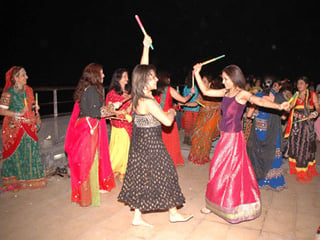 Modern Garba dance during Navratri festival : Preservation or Perversion of Culture ?
Modern Garba dance during Navratri festival : Preservation or Perversion of Culture ?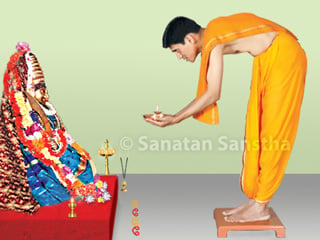 What is the correct method of performing arti to Goddess?
What is the correct method of performing arti to Goddess?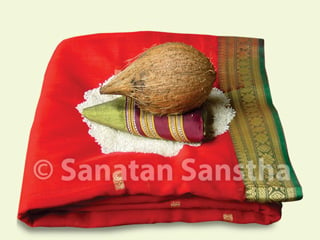 What is the importance of ‘offering a sari’ to the Goddess?
What is the importance of ‘offering a sari’ to the Goddess?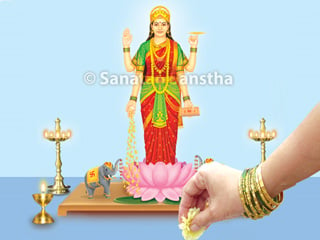 Which specific flower should be offered to a specific Goddess?
Which specific flower should be offered to a specific Goddess?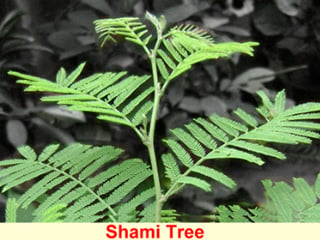 Why is Aparajita form of Goddess Durga worshipped near Shami tree?
Why is Aparajita form of Goddess Durga worshipped near Shami tree?